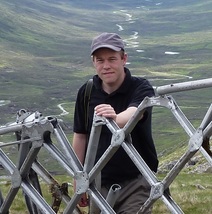Association blog
 The squadron’s second fatal Spitfire accident occurred on 18 July 1939 when Sgt. Plt. Kenneth Mitchell flew into Great Dun Fell in the North Pennines in Mk. I, K9888. Having grown up in Bournemouth he was later employed by Vickers Armstrong, working at the Supermarine Aviation works in Southampton. In 1937 he joined the RAFVR and received his wings in late 1938 Mitchell had taken off from Catterick for a cross country navigation exercise to RAF Kingstown, near Carlisle, necessitating a crossing the Pennine Hills, which lay between the two airfields. After crossing the Pennines on his outbound, north-westerly leg, the exercise was called off because of bad weather and, accordingly, Mitchell turned back for Catterick. By the time he approached the Pennines on the return leg, however, the weather deteriorated to such an extent that visibility had been reduced to virtually nothing. Flying blind through low cloud, Mitchell flew straight into high ground approximately five miles north east of Knock village, by Appleby in Cumbria. The aircraft disintegrated on impact and he was killed instantly. A parachute was on board, but Mitchell never had the opportunity to use it. The crash site was found the following day by a local shepherd at the height of around 2,500 feet. Although the accident was clearly caused by Mitchell flying into a cloud-obscured hillside, the blame was split between both himself and his Flight Commander. Mitchell is believed to have obtained unfavourable weather forecasts but had not shown them to his Flight Commander prior to the flight although, the Accident Report Card states, there were no specific orders to do so. It was also felt Mitchell should have turned back sooner, as the weather deteriorated. The Flight Commander shared the blame with Mitchell for “not ensuring [the] weather [was] O.K. before authorising [the] flt.” [Flying Accident Card for Sgt. Kenneth Mitchell, 18 July 1939, Air Ministry Form 1180, RAF Museum, Hendon]. The accident card goes on to note that the Navigation Officer should also have provided more information on the flight, but that “both he and [the] Flt. Cdr. [were] young & inexperienced” and that there was therefore “no case for censuring them.” [Flying Accident Card for Sgt. Kenneth Mitchell, 18 July 1939, Air Ministry Form 1180, RAF Museum, Hendon] At the time of the accident, Mitchell had only flown 29 hours solo on Spitfires but an additional 345 hours, including dual, on other types. Spitfire I, K9888 was just 10 weeks old when she was struck from charge.  Mark Sheldon with Wellington Bomber remains close by to the Spitfire crash site. Mark Sheldon with Wellington Bomber remains close by to the Spitfire crash site. The photos above were taken by Mark Sheldon, BAE Systems Flight Test Engineer. They show the crash site of Spitfire Mk.I K9888 on Great Dun Fell in the North Pennines. The first photo was taken just below the point of impact looking down in to the Vale of Eden, while the other is of his research colleague, Richard Allenby, holding up one of the small pieces of wreckage that remain nearby. *Permission from the landowner was sought to visit this site.
0 Comments
Leave a Reply. |
Photo Credit:
Rich Cooper/COAP Association BlogUpdates and news direct from the Committee Archives
August 2022
Categories
All
|
